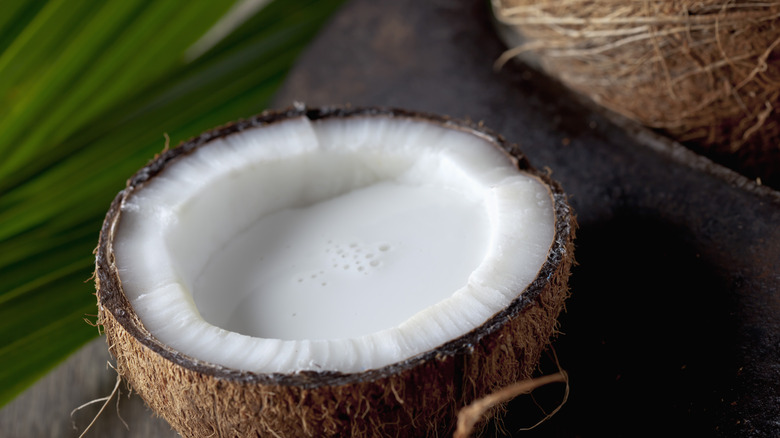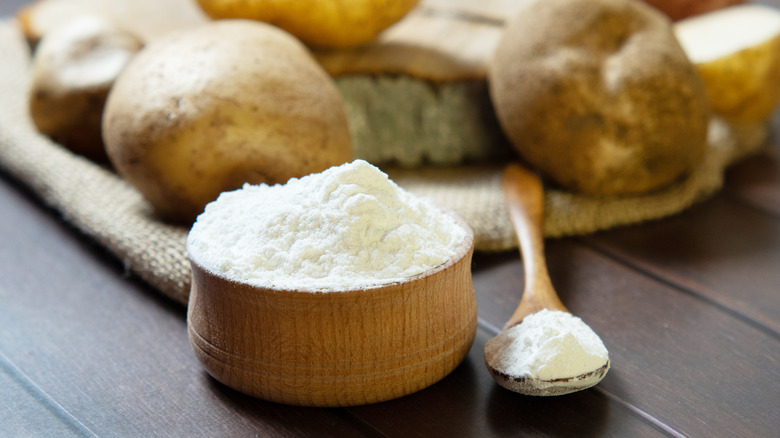Restaurant Veteran Gives Us 16 Ingredients That Will Take Homemade Fried Chicken To The Next Level
Fried chicken is one of those dishes that can be more complicated than they're worth. First, you have to marinate or brine the chicken — overnight, preferably — then dredge it in batter and seasonings. That's before you need to contend with a large quantity of bubbling hot oil.
If you are set on making fried chicken at home, then you should be confident that the time and effort are going to produce restaurant-quality food. I avoided frying chicken at home for years after a spectacularly poor first attempt. It was only after working at a restaurant that offered all-you-can-eat wings that I picked up enough tricks and tips to feel confident in making the dish work.
Although there are many stages to making fried chicken, this does have a benefit — each stage is another part of the recipe that you can enhance in a different way. The list below contains all of the ingredients that professional chefs use to get their fried chicken to the next level, at each stage of the cooking process. I've personally seen them in action, and I use all of them whenever I make fried chicken at home.
1. Buttermilk
Whatever tweaks I end up making to my fried chicken recipe, there's one step I'll never skip –- marinating. However, marinating is about more than just imbuing the chicken with extra flavor, it's also an extremely effective way to tenderize the meat.
Buttermilk is the best choice for a marinade base because it's acidic, meaning it will help break down the structure of the meat as it soaks in the liquid. Plus, its consistency means it provides a nice, thick coating on the chicken. This helps the flour adhere to the meat when you dip it into your breading mixture, allowing it to form a more robust crust. You should marinate your chicken for at least two hours but for the best results, prepare everything the day before and leave it in the fridge overnight. It's also worth being aware that some buttermilk comes with salt already added, so you may need to adjust your seasonings accordingly.
2. Coconut milk
One of the best things about fried chicken is that it's remarkably versatile. In fact, in almost every country I've visited, I've found a delicious version of the dish with its own culinary twist. One of my favorite versions is Asian-style coconut fried chicken, which uses coconut milk instead of buttermilk for the marinade.
The most important thing to remember is that coconut milk isn't naturally acidic. You can marinate the chicken in a combination of buttermilk and coconut milk, but if you're only using the latter, you'll want to add some lime juice to your marinade for it to have a tenderizing effect on the meat. I also tend to switch up my marinade ingredients so they complement the coconut. Personally, I like to use soy sauce for my salty component, and seasonings like ginger, turmeric, and curry powder for flavor. You can also mix in some desiccated coconut — sweetened or unsweetened, depending on your preference — into the breading mixture to boost the flavor and texture even further.
3. Cornstarch
Cornstarch — sometimes referred to as corn flour — is typically used as a thickening agent to bulk up things like soups, sauces, or gravies. However, its natural properties also make it a superb ingredient for breading fried chicken, and you can replace roughly half of your flour mix with cornstarch.
For starters, cornstarch is lighter than regular flour and adheres to the raw chicken really well, so it forms a more consistent, delicate coating on the meat. It's also extremely effective at soaking up moisture from the chicken, so you'll end up with a crispier, crunchier skin after frying. The cornstarch absorbs less excess oil too, so you're less likely to end up with an overly greasy dish. Additionally, I find that cornstarch browns more evenly than flour during cooking — possibly because it's a much finer powder — so it ends up making my fried chicken look more visually appealing, as well.
4. Potato starch
The best fried chicken I've ever had came out of a Jamaican friend's food truck in New Zealand. Having previously worked at a 2-star Michelin restaurant, he had a few tricks up his sleeve, and I eventually pestered him enough to cough up one of his secret ingredients — potato starch.
Being less dense than cornstarch, potato starch makes the coating even crunchier but with an airier texture. Potato starch absorbs even less fat than cornstarch, so there's less chance of ending up with oily chicken. Again, you can replace up to half of your flour with this alternate ingredient. This particular product can be a little hard to find in standard grocery stores, but potato starch is commonly used as a breading ingredient in Asian cuisine. If you've got access to a specialty Asian food shop or market, this will likely be the best place to source a packet.
5. Baking powder
Aside from cornstarch and potato starch, I have one more ingredient that always makes it into my breading mixture to take the texture to the next level. Baking powder might seem like an odd choice, but a small amount can make a huge difference.
Baking powder goes a long way toward making your chicken even crunchier, and you only need to stir about a teaspoon of it into your breading mix per pound of meat. The flavorless powder won't impact the taste of your fried chicken, but it will help absorb moisture which helps the skin and coating crisp up during cooking. Baking powder is traditionally used as a leavening agent because it produces bubbles of gas in things like cakes and breads, and it does a similar thing here. These air pockets also form in the coating of the chicken, giving it a lighter, airier texture. The important thing to remember is that baking powder and baking soda aren't the same thing — the former also contains cream of tartar and cornstarch which play a role in the chemistry that improves the chicken.
6. MSG
Monosodium glutamate — more commonly known by its initialism, MSG — is an ingredient that I find myself having to defend more regularly than I'd like. This is almost wholly due to the fact MSG has been trying to shed a race-based stigma for decades. The idea that MSG is hazardous to your health is nothing more than a myth that's done nothing except hold back culinary excellence.
MSG is essentially just a natural salt, but it does so much more than the common varieties that we're used to. It actually contains a lot less sodium than table salt and doesn't really taste salty in the traditional sense. Rather, just half a teaspoon of MSG in your breading mix or marinade will do a remarkable job of bringing out the umami flavor in the fried chicken. I'll still add regular salt, but it's worth cutting down on your usual quantities. MSG is another ingredient that can be tricky to find in standard supermarkets, but you won't find an Asian specialty food store that doesn't stock it.
7. Pickle brine
Another excellent way to marinate meat before cooking is to use a brine, which is essentially just a fancy name for a salty liquid. The salty brine helps to break down proteins in the meat, tenderizing it, while the chicken also absorbs some of the liquid, leading to a juicier texture.
Like with regular marinades, you can season and flavor your brine to give your chicken even more flavor. However, rather than take the time to make brine from scratch, there's a simple shortcut. Some foods, like pickles, come jarred in brine. I never waste this deliciously tangy liquid, and using it to brine meat is one of my favorite applications for leftover pickle juice. Most of the time, it already comes seasoned with herbs and spices, and you can even add it to a buttermilk marinade. The extra acidity of the pickle brine will only help expedite the tenderization process while giving your meat a more savory flavor profile.
8. Vodka
From pasta sauces to dessert pastry, vodka is becoming increasingly popular as a cooking ingredient these days. Vodka is also a surprisingly versatile addition to your fried chicken recipe, and can dramatically improve the texture and flavor of the dish.
The best part is that you can use vodka in your marinade and your batter. The alcoholic spirit has a neutral taste, but it's more soluble than water. This means it's better at absorbing the flavors of your marinade seasonings before transferring those flavors into the meat. The high alcohol content will also help tenderize your chicken for a juicier bite. Because vodka evaporates at a lower temperature than water when it hits the hot oil, if you add it to your breading mixture, it will dehydrate the batter more quickly. Not only does this prevent the risk of a soggy coating, but the rapid evaporation also causes bubbles to form in the batter, increasing the surface area for a crispier skin.
9. Smoked paprika
A mild spice made from dried bell peppers, paprika is probably one of my most-used seasonings. It adds a mild, sweet heat to dishes and it's versatile enough to use in all sorts of dishes.
However, not all paprika is the same, and for fried chicken I love to season my marinade and batter with the smoked variety. Smoked paprika is common in the cuisine of the Iberian peninsula, and it's made by drying the peppers over an oak fire before grinding them into a powder. I find the woody, smoky flavor of the seasoning gives my chicken a barbecued quality which you won't get from deep-frying the meat. If the paprika spice is too mild for your tastes, you can find hotter varieties of smoked paprika for sale, or add a pinch of cayenne pepper powder to your seasoning mixture. It's pretty hard to overuse paprika in a recipe, so you can add as much as you like without worrying too much about throwing off the flavor balance.
10. Onion powder
Onion powder is another seasoning that makes into the vast majority of my savory recipes, as it can elevate practically any dish without the need for cutting and cooking fresh onions. I'll use it on fried eggs, in homemade burger patties, soups, stews, and obviously — fried chicken.
Made from dried, ground onions, this powder adds a rich, savory aspect to the fried chicken batter. I also suggest adding a generous amount to your marinade so it can infuse deep into the meat itself. You can make the powder yourself, too, by dehydrating chopped onions and grinding them up with a mortar and pestle. It's not that this seasoning is particularly expensive — quite the opposite — but it helps if you want to adjust the flavor. Most store-bought powder is made with yellow and white onions, but you can create a sharper seasoning by using red onions, or a milder, sweeter one with shallots.
11. Garlic powder
I probably use garlic powder as a seasoning only slightly less than I use salt and pepper. In my opinion, there are very few savory dishes that garlic doesn't improve, and fried chicken definitely isn't one of them.
Using fresh garlic works well enough in a marinade, but it's not particularly suitable for adding to the batter. Unfortunately, the oil tends to burn it when it's on the surface of the chicken, which is why powder is the way to go. When it comes to how much garlic to use, I subscribe to the "follow your heart" philosophy, although you do need to double-check the label of your seasoning. It's possible to buy garlic powder or garlic salt. The former is simply dried and ground garlic, but the latter is combined with table salt. If you're using garlic salt, you'll want to add less regular salt to your marinade or breading mix. Like with onion powder, you can make garlic powder yourself in the same way, or even combine and jar the two along with other powdered ingredients to make a handy all-in-one seasoning.
12. Mustard powder
The ideal ingredient for when you want to add some earthy heat to a dish, mustard comes in plenty of different styles, giving you a ton of control over your flavors. It's an excellent ingredient to introduce more flavor into your fried chicken recipe, but it comes with a drawback. I find the consistency of most mustards makes it hard to incorporate properly into a marinade or breading mix; fortunately, there's a solution.
Mustard powder is essentially just very finely ground mustard seeds, but this dry seasoning makes it much easier to add depth and spice to fried chicken. It's worth investing in mustard powder because it can be used to upgrade all manner of savory dishes. You can use mustard powder to enhance burger patties, enrich stews, or even as a dry rub for the majority of meats. If you can't find the powder at the store, you can always grind up the seeds yourself and the ingredient will work just as well as the pre-made variety.
13. Dried citrus
Dehydrated citrus might not be the first ingredient that comes to mind when you think about fried chicken, but it's more effective than you might think. The slightly sour tang will noticeably upgrade the savory factor of the chicken.
You can grind up dehydrated lemon, lime, or even orange to add to your marinade or breading mixture, but there's also a specific type of dried citrus that's worth tracking down to take your fried chicken to the next level. Black limes are a common ingredient in Middle Eastern cuisine, and have a few different names that vary from country to country. These dried citrus fruit have a fermented, citrus-forward quality to them that makes them perfect for grinding or grating into your buttermilk marinade. Black limes are potent, so you don't want to add too much. If it's your first time using them, it's better to use a smaller amount than you think you'll need and adjust the quantity next time.
14. Bacon grease
Although using a marinade and seasoning your breading mix are the most common ways to improve the flavor of fried chicken, they're not the only parts of the recipe you can tweak. It's also possible to adjust the composition of the oil you're frying the chicken in.
I tend to use canola or peanut oil to fry chicken, as both of these have high smoke points. The smoke point of oil being the temperature at which it starts to break down. When oil breaks down, it can make food taste acrid and astringent, so these are oils that can handle the heat. However, I always love adding a healthy amount of bacon grease to whichever oil I'm using. This gives the chicken a deliciously salty and smoky flavor that can't be beat. You can't buy bacon grease at a store, so you'll have to save it yourself, but this is as simple as straining the grease into a jar through a coffee filter and keeping it in the fridge.
15. Honey
Out of the countless fried chicken varieties to choose from, my favorite is when they're smothered in buffalo hot sauce. That didn't used to be the case, as I often found the sauce too thin or vinegary — that changed when I started managing a restaurant that took fried chicken seriously.
As it turned out, the sauce recipe was incredibly straightforward, and started with melting butter — you don't want to know how much — into the hot sauce. This makes the sauce extra rich and creamy, and the fat helps round out the acidity. The only other ingredient in our buffalo sauce was honey and trust me, it makes all the difference. Combined with the butter, it creates an even more luxurious texture, and its stickiness helps the sauce cling to the outside of the chicken. Its natural sweetness isn't overpowering and cuts through the vinegary flavors while complementing the spice.
16. Gochujang
The recipe for the buffalo sauce we made at this restaurant never changed, as it was something we were well known for. We were also based in the U.K., and our hot sauce came from the U.S., which caused some issues during the COVID-19 pandemic when our suppliers ran dry. In an effort to persevere, we ran with a few alternative flavors, one of which was Korean-style wings.
The base of this sauce was a Korean chili paste, called gochujang. Gochujang is simultaneously sweet, spicy, and smoky, with a hint of funk from the fermented ingredients, and it's delicious on fried chicken. Our Korean wings were so popular, we made them a permanent menu mixture, and the sauce is super simple. You can combine the paste with garlic and ginger for extra flavor, then add soy sauce to introduce a salty component. We used brown sugar for sweetness — although honey works just as well — then a splash of rice vinegar to balance the ingredients with its acidity.

















